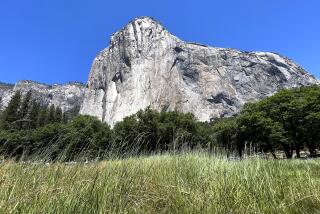Arizona decides to close most state parks
- Share via
Wrestling with a multibillion-dollar budget deficit, Arizona decided Friday to close nearly all of its state parks, including the famed Tombstone Courthouse and Yuma Territorial Prison.
The State Parks Board unanimously voted to close 13 parks by June 3. Eight others had already been closed, and the decision would leave nine open -- but only if the board can raise $3 million this year.
The action represents the largest closure of state parks in the nation, although several other states are considering similar moves.
“It’s a dark day for the Arizona state parks system,” said Renee Bahl, the system’s executive director.
“We have 65,000 acres around the state and the majority of them are closing.”
The Arizona parks receive about 2.3 million visitors per year who bring about $266 million into the state, Bahl said.
“It’s unfortunate that a short-term recession is having an impact on our future,” Bahl said.
Arizona isn’t the only state struggling to support its parks.
In May, Gov. Arnold Schwarzenegger proposed closing 220 of California’s 278 state parks to help close a multibillion-dollar deficit but backed off after protests.
This month, Schwarzenegger proposed to expand oil drilling off the Santa Barbara coast to provide up to $140 million for state parks in place of state funding, said Jerry Emory, the director of communications for the California State Parks Foundation.
Louisiana and Iowa may close parks due to budget problems. Other states have transferred their parks to local control to save money.
In Idaho, Gov. C.L. “Butch” Otter has proposed disbanding the state parks department, saving $10 million by selling the headquarters and shifting management of 30 state parks and recreation programs to another agency, said Jennifer Wernex, spokeswoman for the Idaho Parks and Recreation Department.
Phil McKnelly, the executive director of the National Assn. of State Park Directors, lamented the decision to close parks amid a recession.
“This is the time when people need to be getting out and releasing stress,” he said.
The Arizona State Parks budget has gone from $26 million in the 2009 fiscal year to $7.5 million as the legislature has struggled to close its budget gap.
Some local jurisdictions that depend on the flow of tourist dollars have mobilized to protect their parks.
The town of Camp Verde came up with $18,000 of its own money to keep Ft. Verde State Historic Park operating.
For Mike Scannell, the Camp Verde town manager, closing the fort -- one of the best-preserved Army forts from the period of the Indian Wars -- simply wasn’t an option for the community of 12,000.
“We clearly had to do something,” he said.
Closing the park would have dealt a “catastrophic” blow to Camp Verde’s economy, Scannell said. “It’s a real important part of the history of the town.”
But even with the extra funds, the town was able to only delay the closing of the park by a month, from Feb. 22 to March 29.
The town plans to use the time to come up with a funding plan to keep the fort open permanently.
More to Read
Sign up for Essential California
The most important California stories and recommendations in your inbox every morning.
You may occasionally receive promotional content from the Los Angeles Times.














